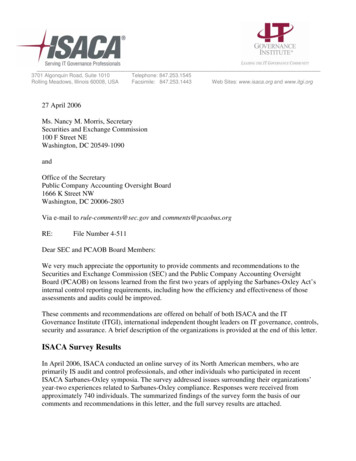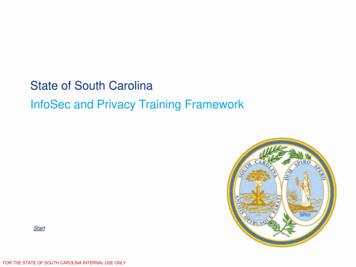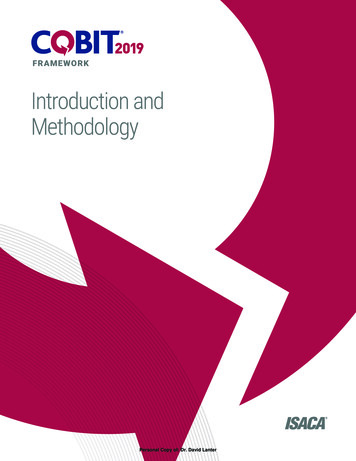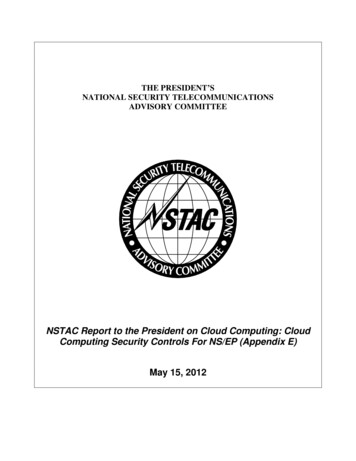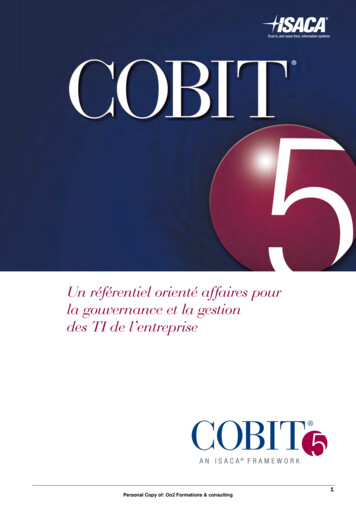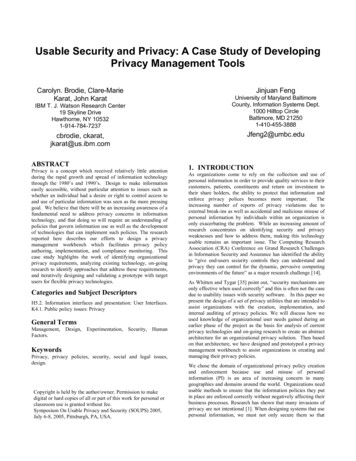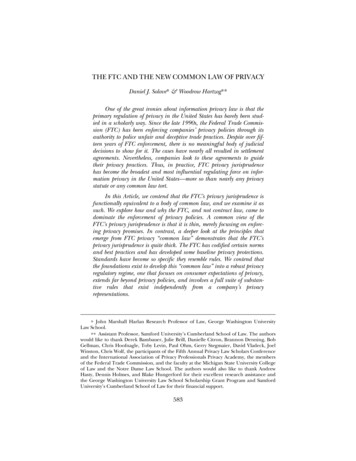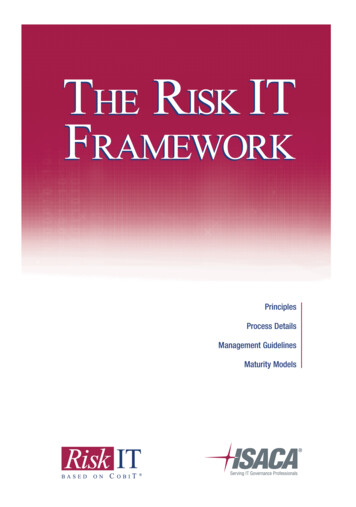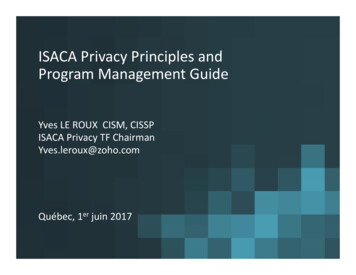
Transcription
ISACA Privacy Principles andProgram Management GuideYves LE ROUX CISM, CISSPISACA Privacy TF ChairmanYves.leroux@zoho.comQuébec, 1er juin 2017
Privacy Guidance Task Force Established in June 2014, in order to develop a series of practicalprivacy knowledge products in support of members currentlyresponsible for managing or supporting privacy initiatives, and non‐members in privacy operational roles. First action: realizing a survey “How enterprises are managing theirPrivacy function” Second action: Elaborating a « Privacy Principles and ProgramManagement Guide”2 2014 CA. ALL RIGHTS RESERVED.
Development team Rebecca Herold, CISA, CISM, CIPM, CIPP/US, CIPP/IT,CISSP, FLMI, USA (Lead Developer) Alberto Ramirez Ayon, CISA, CISM, CRISC, CBCP, CIAM,Seguros Monterrey New York Life, Mexico Frank Cindrich, CGEIT, CIPP/US, CIPP/G, PwC, USA Nancy A. Cohen, CPA, CIPP/US, ISACA, USA Alan Lee, CISA, CISM, CISSP, Ernst & Young, Hong Kong Yves Le Roux, CISM, CISSP, CA Technologies, France,Chair John O’ Driscoll, CISA, CISM, CGEIT, CIA, ANZ, Australia Fidel Santiago, CISA, CISM, Belgium Roberto Soriano, CISA, CISM, CRISC, Seidor, Spain3 2014 CA. ALL RIGHTS RESERVED.
Document structure 1/2 Two volumes (currently tome I is available, tome II planned forJuly 2017) Volume I is organized into six chapters and seven appendices, Chapter 1—Introduction to PrivacyIntroduction to privacy, including an explanation of why security and privacy are not the sameand a list of privacy terms. Chapter 2—Privacy Legal Models, Categories and Emerging ConceptsOverview of seven different categories of privacy as defined by major privacy laws,regulations and frameworks. Chapter 3—Privacy Risk from New and Evolving TechnologiesOverview of relatively new technologies and their corresponding privacy risk and impacts tothe seven privacy categories. Chapter 4—ISACA Privacy Principles Description of the 14 ISACA privacyprinciples. Chapter 5—COBIT 5 and Privacy Guidance on how to embed privacythroughout enterprise processes and technologies, using COBIT 5 as the4overarching framework for information governance and management of 2014 CA. ALL RIGHTS RESERVED.
Document structure 2/2 Chapter 6—Establishing a Privacy Protection ProgramGuidance on how to use the concepts that are provided in earlier chapters to create,implement and sustain a privacy program. The guidance is divided into major phases: Enabling privacy protection changeImplementing a life cycle approach to privacy governance and managementKey success factors for a successful implementation of a privacy management programCreating the appropriate privacy protection environment and enabling changeAppendix A—List of Privacy Laws and Regulations by RegionOverview and listing of privacy laws, regulations and standards in the different regions ofthe world.Appendix B—Legal Actions for Privacy by CountryOverview and listings of some of the legal privacy protections throughout the world,worldwide legal enforcement actions for privacy, and global industry‐specific privacystandards.Appendix C—Privacy Standards, Frameworks and Self‐Regulation ProgramsExisting privacy standards, principles and frameworks, and relevant security standards.Appendix D—Professional Privacy and Security CertificationsList of generally and worldwide accepted professional certifications that are related toprivacy.Appendix E—Connecting the ISACA Privacy Principles to Other Privacy Standards,Frameworks, Models and Good PracticesList of privacy advice publications and standards to consider and how the ISACA privacy5principles map to a few of these standards. enterprise IT. 2014 CA. ALL RIGHTS RESERVED.
What is privacy? No single world‐wide definition of privacy Seven categories of privacy (from“European data protection: coming ofage?” edited by Serge Gutwirth, Ronald Leenes, Paul de Hert and Yves Poullet)– Privacy of the person– Privacy of behaviour and actions– Privacy of communication– Privacy of association– Privacy of data and image (information)– Privacy of thoughts and feelings– Privacy of location and space (territorial) More details & examples h/Documents/Privacy‐Infographic res eng 0117.pdf6 2014 CA. ALL RIGHTS RESERVED.
Applications of Privacy categories to relatively newtechnologies Social media Cloud computing Apps (the term most commonly used for mobile applications) Big Data Analytics Internet of Things BYOD (the common term used for “bring your own device” practicesin organizations) including wearable technologies Tracking and surveillance technologies7 2014 CA. ALL RIGHTS RESERVED.
8XXXXXXTracking and surveillanceInternet of ThingsXBYODBig Data AnalyticsPrivacy of the personAppsCloud computingSocial mediaPRIVACY CATEGORIES\TECHNOLOGIESXPrivacy of behaviour and actionXPrivacy of communicationXXXXXXPrivacy of data and imageXXXXXXXPrivacy of thought and feelingsXXXXXXXPrivacy of location and spaceXPrivacy of association 2014 CA. ALL RIGHTS RESERVED.XXXXXXXXXXXXX
Data Privacy legislations around the world107 countries have put in place legislation to secure the protection ofdata and privacy.9 2014 CA. ALL RIGHTS RESERVED.
Models used in data protection laws Comprehensive Modele.g. European Union countries and the Canadian provinces Sectoral Modele.g. United States and Japan Co‐Regulatory Modele.g. Australia, New Zealand and the Netherlands. Self‐Regulatory Modele.g. Network Advertising Initiative (NAI) Code of Conduct and NorthAmerican Energy Standards Board (NAESB)10 2014 CA. ALL RIGHTS RESERVED.
THE 14 ISACA PRIVACY PRINCIPLES 1/2After studying existing privacy standards, frameworks andprinciples, ISACA defined a uniform set of practicalprinciples Principle1: Choice and Consent Principle 2: Legitimate Purpose Specification and UseLimitation Principle 3: Personal information and SensitiveInformation Life Cycle Principle 4: Accuracy and Quality Principle 5: Openness, Transparency and Notice Principle 6: Individual Participation Principle 7: Accountability11 2014 CA. ALL RIGHTS RESERVED.
THE 14 ISACA PRIVACY PRINCIPLES 2/2 Principle 8: Security SafeguardsPrinciple 9: Monitoring, Measuring and ReportingPrinciple 10: Preventing HarmPrinciple 11: Third Party / Vendor ManagementPrinciple 12: Breach ManagementPrinciple 13: Security and Privacy by DesignPrinciple 14: Free flow of information and legitimate restriction For more details 4kG3VQ6A3TpAQaclKA .pdf12 2014 CA. ALL RIGHTS RESERVED.
Mapping of the ISACA Privacy Principles13 2014 CA. ALL RIGHTS RESERVED.
COBIT 5 ENABLER: SYSTEMIC MODEL WITHINTERACTING ENABLERS14 2014 CA. ALL RIGHTS RESERVED.
USING COBIT 5 ENABLERS TO SUPPORT THEPRIVACY PROGRAM1. Privacy policies, principles and frameworks (e.g., the ISACA PrivacyPrinciples, internal organizational privacy policies, the APEC PrivacyFramework, etc.)2. Processes, including privacy-specific details and activities (e.g., identityverification, providing notice, offering opt-in, etc.)3. Privacy-specific organizational structures (e.g., Information Technology,Human Resources, Physical Security, Legal Counsel, etc.)4. In terms of culture, ethics and behavior, factors determining the success ofprivacy governance and management (e.g., executive support of the privacyprogram, providing privacy training, etc.)5. Privacy-specific information types (e.g., personal information, sensitiveinformation, and other types of information that can have privacy impacts,such as communications metadata, etc.) and concepts for enabling privacygovernance and management within the enterprise6. Service capabilities required to provide privacy related functions andactivities to an enterprise (e.g., applications, infrastructure, technologies, etc.)7. People, skills and competencies specific for privacy (e.g., understanding of privacyenhancing technologies, knowing geographic locations where personal information iscollected from and where it is stored, privacy certifications, etc.)15 2014 CA. ALL RIGHTS RESERVED.
COBIT 5 ENABLER:PRINCIPLES, POLICIES AND FRAMEWORKS16 2014 CA. ALL RIGHTS RESERVED.
PRINCIPLES, POLICIES AND FRAMEWORKS17 2014 CA. ALL RIGHTS RESERVED.
COBIT 5 PROCESSES ENABLER18 2014 CA. ALL RIGHTS RESERVED.
PROCESS For each process, a limited number of privacy‐specificprocess goals are included, and for each process goal alimited number of privacy‐specific example metrics islisted. For each practice, we will find privacy‐specific practiceinputs and outputs (work products), with indication oforigin and destination and privacy‐specific processactivities Volume II will provide the details of privacy‐specificprocesses (those that involve personal information, orcould be used to reveal details about individuals and theirassociated lives)19 2014 CA. ALL RIGHTS RESERVED.
20 2014 CA. ALL RIGHTS RESERVED.
EDM02 ENSURE BENEFITS DELIVERYEDM02 Ensure Benefits DeliveryArea: GovernanceDomain: Evaluate, Direct and MonitorCOBIT 5 Process DescriptionOptimize the value contribution to the business from the business processes, IT services and IT assets resulting from investmentsmade by IT at acceptable costs.COBIT 5 Process Purpose StatementSecure optimal value from IT-enabled initiatives, services and assets; cost-efficient delivery of solutions and services; and a reliableand accurate picture of costs and likely benefits so that business needs are supported effectively and efficiently.Primary Privacy Principles Involved: Principle 10: Preventing Harm Principle 12: Breach Management Principle 13: Security and Privacy by Design Principle 14: Free Flow of Information & Legitimate RestrictionEDM02 Privacy-specific Process Goals and MetricsPrivacy-specific Process GoalsRelated Metrics1.Benefits, costs and risk of information security investments arebalanced and managed and contribute optimal value. 1.Privacy harms and privacy breaches are prevented. 1.Information flow is not restricted. 21Percent of risk reduction vs. budget deviation (budgetedvs. projection)Level of stakeholder satisfaction with the privacyprogram requirements in place, based on surveysNumber of breachesLevel of Data Subject satisfaction with privacy, based onphone calls, complaints, and surveysNumber of communications with Data ProtectionAuthorities necessary to enable personal information 2014 CA. ALL RIGHTS RESERVED.transmissions
EDM02 ENSURE BENEFITS DELIVERYEDM02 Privacy‐specific Process Practices, Inputs/Outputs and ActivitiesGovernance PracticePrivacy‐specific ActivitiesEDM02.01 Evaluate value optimization.Continually evaluate the portfolio of IT‐enabledinvestments, services and assets to determine thelikelihood of achieving enterprise objectives anddelivering value at a reasonable cost.Identify and make judgement on any changes indirection that need to be given to management tooptimise value creation.EDM02.02 Direct value optimization.Direct value management principles and practices toenable optimal value realisation from IT‐enabledinvestments throughout their full economic life cycle. EDM02.03 Monitor value optimization.Monitor the key goals and metrics to determine theextent to which the business is generating theexpected value and benefits to the enterprise from IT‐enabled investments and services. Identify significant22issues and consider corrective actions. Identify and record the requirements of stakeholders (such as shareholders,regulators, auditors and customers) for protecting their interests and deliveringvalue through privacy management activity. Set direction accordingly.Identify and record the expectations of Data Subjects for protecting their personalinformation and privacy and determine the value of the privacy managementactivities. Change direction as appropriate.Establish a method of demonstrating the value of privacy management activities(including defining and collecting relevant data) to ensure the efficient use ofexisting privacy‐related assets.Establish a method of demonstrating the value to Data Subjects of privacyprotection activities (including defining and collecting relevant data) to ensure theeffective use of existing privacy‐related assets.Ensure the use of financial and non‐financial measures to describe the added valueof privacy initiatives.Use business‐focused methods of reporting on the added value of privacy initiatives.Track outcomes of privacy initiatives and compare to expectations to ensure valuedelivery against business goals.Track outcomes of providing privacy practices transparency to Data Subjects andData Protection Authorities and compare to expectations to ensure value deliverywith original goals. 2014 CA. ALL RIGHTS RESERVED.
APO03 MANAGE ENTERPRISE ARCHITECTUREAPO03 Manage Enterprise ArchitectureArea: ManagementDomain: Align, Plan and OrganizeCOBIT 5 Process DescriptionEstablish a common architecture consisting of business process, information, data, application and technology architecturelayers for effectively and efficiently realizing enterprise and IT strategies by creating key models and practices that describe thebaseline and target architectures. Define requirements for taxonomy, standards, guidelines, procedures, templates and tools,and provide a linkage for these components. Improve alignment, increase agility, improve quality of information and generatepotential cost savings through initiatives such as reuse of building block components.COBIT 5 Process Purpose StatementRepresent the different building blocks that make up the enterprise and their interrelationships as well as the principles guidingtheir design and evolution over time, enabling a standard, responsive and efficient delivery of operational and strategicobjectives.Primary Privacy Principles Involved: Principle 8: Security Safeguards Principle 9: Monitoring, Measuring and Reporting Principle 10: Preventing Harm Principle 11: Third Party / Vendor Management Principle 12: Breach Management Principle 13: Security and Privacy by Design Principle 14: Free Flow of Information & Legitimate RestrictionAPO03 Privacy-specific Process Goals and MetricsPrivacy-specific Process GoalsRelated Metrics1. Privacy requirements are embedded within the enterprise Number of exceptions to privacy managementarchitecture and translated into a formal privacy protectionarchitecture standardsand management architecture.2. Privacy management architecture is understood as part of the Number of deviations between privacy managementoverall enterprise architecture.architecture and enterprise architecture3. Privacy management architecture is aligned and evolves with Date of last review and/or update to privacy controlschanges to the enterprise architecture.applied to enterprise architecture4. A privacy management architecture framework and Percent of projects that use the privacy managementmethodology are used to enable reuse of privacyarchitecture framework and methodology23managementcomponents across the enterprise. 2014 CA. ALL RIGHTS RESERVED. Number of people trained in the privacy managementframework and methodology
APO03 MANAGE ENTERPRISE ARCHITECTUREAPO03 Privacy‐specific Process Practices, Inputs/Outputs and ActivitiesManagement PracticePrivacy‐specific ActivitiesAPO03.01 Develop the enterprise privacy management architecture vision.The privacy management architecture visionprovides a first‐cut, high‐level description ofthe baseline and target architectures, coveringthe business, information, data, application,and technology domains. The architecturevision provides the sponsor with a key tool tosell the benefits of the proposed capability tostakeholders within the enterprise. Thearchitecture vision describes how the newcapability will meet enterprise goals andstrategic objectives and address stakeholderconcerns when implemented.APO03.02 Define reference architecture.The reference architecture describes thecurrent and target architectures for thebusiness, information, data, application andtechnology domains.24 Define privacy management objectives and requirements for theenterprise architecture.Define the privacy management value proposition and related goalsand metrics.Consider industry good privacy practices, such as using the ISACAPrivacy Principles, in building the privacy management architecturevision.Ensure inclusion of privacy artefacts, policies and standards in thearchitecture repository.Ensure privacy is integrated throughout all architectural domains (e.g.,business, information, data, applications, technology).Establish a centralised personal information inventory for all areas ofthe enterprise to use. 2014 CA. ALL RIGHTS RESERVED.Establisha catalogue of privacy tools, standards and technologies to beavailable for enterprise‐wide use
COBIT 5 ENABLER:ORGANISATIONAL STRUCTURES25 2014 CA. ALL RIGHTS RESERVED.
ORGANIZATIONAL STRUCTURESNew organizational structures Chief Privacy Officer (CPO) / Data Protection Officer (DPO)Privacy Steering Committee (PSC)Privacy Manager (PM)Enterprise Risk Management (ERM) CommitteeData ProcessorIn Volume II detailed descriptions of these groups and roles will be provided: Composition—An appropriate skill set should be required of all members of the organisationalgroup.Mandate, operating principles, span of control and authority level—These elements describethe practical arrangements of how the structure will operate, the boundaries of theorganisational structure’s decision rights, the responsibilities and accountabilities, and theescalation path or required actions in case of problems.High‐level RACI chart—RACI charts link process activities to organisational structures and/orindividual roles in the enterprise. The charts describe the level of involvement of each role, foreach process practice: accountable, responsible, consulted or informed.Inputs/Outputs—A structure requires inputs (typically information) before it can make informeddecisions; it produces outputs, such as decisions, other information or requests for additionalinputs.26 2014 CA. ALL RIGHTS RESERVED.
COBIT 5 ENABLER:CULTURE, ETHICS AND BEHAVIOUR27 2014 CA. ALL RIGHTS RESERVED.
CULTURE, ETHICS AND BEHAVIOR ENABLEREight desirable privacy behaviors: Privacy protecting actions are performed in daily operations. Personnel respect the importance of privacy policies, procedures, standards andprinciples. Personnel are provided with sufficient and detailed privacy guidance, and areencouraged to participate in and proactively suggest privacy protectionimprovements. Everyone is responsible and accountable for the protection of personal informationwithin the enterprise. Stakeholders are aware of how to identify and respond to privacy threats andvulnerabilities. Management proactively supports and anticipates new privacy protectioninnovations and communicates this to the enterprise. The enterprise is receptive to account for and deal with new privacy challenges. Business management engages in continuous cross‐functional collaboration toallow for efficient and effective privacy programs.28 Executive management recognizes the business value of privacy protection. 2014 CA. ALL RIGHTS RESERVED.
CULTURE, ETHICS AND BEHAVIOR ENABLERFor each of the behaviors defined, the following attributes are: Organisational privacy ethics: Determined by the values by whichthe enterprise wants to operate Individual privacy ethics: Determined by the personal values of eachindividual in the enterprise and, to an important extent, depend onexternal factors, such as personal experiences, beliefs, socio‐economic background and geographic location Leadership: Ways that leadership can influence desired behavior andprivacy‐impacting actions:– Privacy policy enforcement and rules and norms– Incentives and rewards– Communications and activities Detaileddescription will be in Volume II29 2014 CA. ALL RIGHTS RESERVED.
COBIT 5 ENABLER: INFORMATION30 2014 CA. ALL RIGHTS RESERVED.
INFORMATIONThe following items are discussed:1. The information model2. Examples of common information types3. Information stakeholders and how to identify the impacted parties within the enterprise4. Information life cycle, describing the different phases of information management in thiscontextFor each of the examples of common information types, we provide: Goals—This describes a number of goals to be achieved, using the three categories defined in theCOBIT 5 information model. For these information types, goals for information are divided into threedimensions of quality:– Intrinsic quality—The extent to which data values are in conformance with the actual or truevalues– Contextual quality—The extent to which information is applicable to the task of the informationuser and is presented in an intelligible and clear manner, recognizing that information qualitydepends on the context of use– Privacy/accessibility quality—The extent to which information is available or obtainableLife cycle—A specific description of the life cycle requirements Good practices for this type of information—A description of typical contents and structure31 2014 CA. ALL RIGHTS RESERVED.
EXAMPLES OF INFORMATION TYPES 1/2Privacy management strategyPrivacy management budgetPrivacy management planPrivacy policiesPrivacy principlesPrivacy standardsPrivacy proceduresPrivacy protection requirements, which can include:–Privacy protection configuration requirements– SLA/OLA privacy protection requirementsTraining and Awareness material 32 2014 CA. ALL RIGHTS RESERVED.
EXAMPLES OF INFORMATION TYPES 2/2 Privacy management review reports, which include:–Privacy management audit findings– Privacy management maturity report– Privacy impact assessment– Privacy management‐related risk management Threat analysis Vulnerability assessment reports Harms analysis Privacy management dashboard (or equivalent), whichincludes:–Privacy breaches– Privacy management problems– Privacy compliance fines and penalties– Privacy management metrics33 2014 CA. ALL RIGHTS RESERVED.
INFORMATION34 2014 CA. ALL RIGHTS RESERVED.
COBIT 5 ENABLER:SERVICES, INFRASTRUCTURE AND APPLICATIONS35 2014 CA. ALL RIGHTS RESERVED.
SERVICES, INFRASTRUCTURE AND APPLICATIONSExamples of potential privacy‐related services (1/2) Privacy Management Architecture Privacy Training and Awareness Communications Provide a process to allow Data Subjects (individuals) to get accessto their associated personal information Provide privacy protecting development (development in line withprivacy by design standards) Privacy Assessments Provide legal resources for privacy protections Provide systems with adequate privacy protections andconfigurations, supporting privacy requirements and privacyarchitecture Provide user (data processor) access and access rights to personalinformation in line with business and legal requirements36 2014 CA. ALL RIGHTS RESERVED.
SERVICES, INFRASTRUCTURE AND APPLICATIONSExamples of potential privacy‐related services (2/2) Provide adequate protection against inappropriate sharing, misuse,unauthorized access, malware, external attacks and intrusion attempts Provide adequate privacy incident response Provide privacy protection testing Provide monitoring and alert services for privacy‐impacting eventsFor each of these service capabilities, we provide: Detailed description of the service, including business functionality Attributes: The inputs, supporting technologies (including applicationsand infrastructure) Goal: The quality and compliance goals for each service capability andthe related metrics37 2014 CA. ALL RIGHTS RESERVED.
COBIT 5 ENABLER:PEOPLE, SKILLS AND COMPETENCIES38 2014 CA. ALL RIGHTS RESERVED.
PEOPLE, SKILLS AND COMPETENCIESTo effectively operate the privacy function within an enterprise, individualswith appropriate knowledge and experience (e.g., skills and competencies)must exercise that function. Some typical privacy‐related skills andcompetencies are: Privacy management governance Privacy management strategy formulation Privacy risks and harms management Privacy management architecture development Privacy management operations Privacy impact assessment, testing and complianceFor each of the skills and competencies, the following attributes aredescribed: Skill description and definition Experience, education and qualifications required for theskill/competency Knowledge, technical skills and behavioral skills Related structure (if relevant):39 2014 CA. ALL RIGHTS RESERVED.
ADAPTING THE ISACA PRIVACY PRINCIPLESTO THE ENTERPRISE ENVIRONMENTThis section provides generic guidance for a privacy governance andmanagement. Major considerations discussed include: Considering the context for which personal information iscollected, and how it is used within the enterprise’s privacycontext. How to create the appropriate privacy protection environmentfor your organization to match your business environment. Recognizing and addressing privacy protection pain points andtrigger events. Enabling privacy protection change. Implementing a life cycle approach to privacy governance andmanagement.40 2014 CA. ALL RIGHTS RESERVED.
IMPLEMENTATION LIFE CYCLE SEVEN PHASES Phase 1: What are the privacy protection program drivers? Phase 2: Where is the enterprise now with the privacymanagement program? Phase 3: Where does the enterprise want to be with theprivacy management program? Phase 4: What needs to be done for the privacymanagement program? Phase 5: How does the enterprise get the new or updatedprivacy management program? Phase 6: Was there success with the privacy managementprogram plans? Phase 7: How does the enterprise achieve continuedprivacy protection program improvement?41 2014 CA. ALL RIGHTS RESERVED.
ADAPTING THE ISACA PRIVACY PRINCIPLESTO THE ENTERPRISE ENVIRONMENT The ISACA Privacy Program Management Guide wascreated to provide information assurance practitioners ofall kinds (information security, privacy, risk management,audit, legal, etc.) with a practical guide to creating,improving and evaluating a privacy program specific to apractitioner’s own organization, and to support or be usedin conjunction with other privacy frameworks, goodpractices and standards. In order to facilitate this work, we describe and explore therelationship of the ISACA privacy principles to some of theother existing privacy frameworks, good practices andstandards.42 2014 CA. ALL RIGHTS RESERVED.
43Yves.Leroux @zoho.com 2014 CA. ALL RIGHTS RESERVED.
44 2014 CA. ALL RIGHTS RESERVED.
THE 14 ISACA PRIVACY PRINCIPLES 1/2 Afterstudying existing privacy standards, frameworks and principles, ISACA defined a uniform set of practical principles Principle1: Choice and Consent Principle 2: Legitimate Purpose Specification and Use Limitation Principle 3: Personal information and Sensitive

